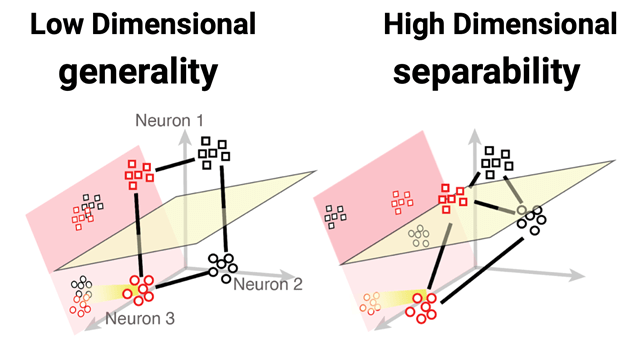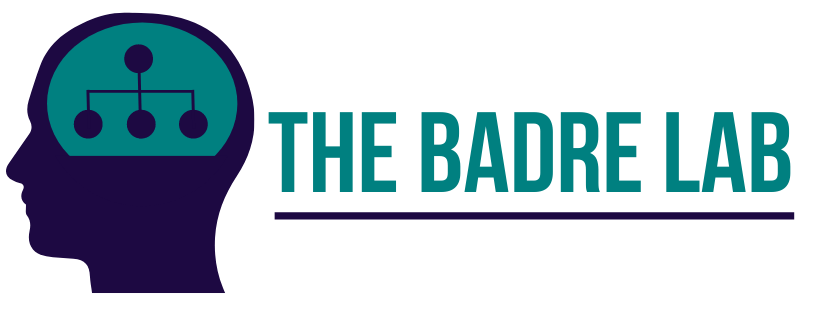Research
How do we select appropriate actions to reach a desired goal? How do we implement control to retrieve information from memory?
Cognitive control involves choosing from a set of actions or representations in order to achieve a certain goal or outcome. We use cognitive control to carry out a variety of tasks, from making a cup of coffee to remembering where the house keys are. The frontal lobes broadly support cognitive control; regions within the frontal lobe guide action selection, so that we add the coffee grounds before turning on the coffee maker. Regions within the frontal lobe also guide memory retrieval, so that we can still search for our keys even when limited external cues are available.
Our lab is interested in how the organization of the frontal lobe influences goal-directed behavior, as well as dissociations and interactions between the frontal and medial temporal lobe regions in their contribution to memory function. In our research, we use a variety of methods to investigate these questions, including functional magnetic resonance imaging (fMRI) and the behavioral testing of healthy adults and patient populations.
The Badre Lab’s research is supported by The National Institutes of Health, The Office of Naval Research and Brown University.

The role of representation learning in improving multitasking
Human performance on a task deteriorates when it is performed concurrently with another task. This cost has been generally attributed to competition for shared computational resources with a long-standing debate about the specific nature of these resources (central or local). Extensive multitasking practice is known to reduce and sometimes abolish these costs, and this improvement has been variously attributed to changes in central processing, more efficient task scheduling, automatization, or the learning of specialized task-specific specific representations. Applying the lens of representational geometry on multitasking costs and practice effects, we are investigating how representation learning shapes multitasking costs.

Balancing Control Demands In Neural Firing Space
Cognitive control is the brain’s ability to guide thoughts and actions based on varying goals and contexts. The human cognitive control system is incredibly flexible because any input stimulus can lead to any output based on internally maintained goals, contexts, and rules. A hallmark of human control is that the same input can lead to multiple outputs depending on these factors, and we posit that there must be some neural representation of a task which allows this flexibility.
Research has shown that these neural representations depend on a delicate balance between separability and generality. Why does this tradeoff matter for cognitive control? We know the same input can lead to multiple outputs. For example, you may have different actions in response to your phone buzzing. At home, you pick it up, but when you’re driving you ignore it. This rule needs to be general enough to apply to both a Twitter and a text chime, but separable enough to know the difference between being in the driver’s seat on the road and in your garage. Understanding how neural populations manage this separability / generality tradeoff in their representations can tell us a lot about their function. This project aims to quantify this balance in neural populations engaged in cognitive control tasks, through an emergent property in neural firing called dimensionality.
The Role of Conjunctive Representations in Prioritizing and Gating of Planned Actions
For flexible goal-directed behavior, prioritizing and selecting a specific action among multiple planned candidates is critical. Such control processes require gating mechanisms of task-relevant information into and out from working memory, which could reflect the predicted utility of information for output events. Yet, most studies investigating gating mechanisms have focused on control over representations of individual items rather than the entire profile of actions. Here, we assess the role of conjunctive representations that nonlinearly integrate task-relevant features in maintenance and to prioritization of action plans. For each trial, participants prepared two independent rule-dependent actions simultaneously, then they were retro-cued to use one of the planned actions. Prior to encoding, each action was assigned to be a high or low priority action by changing its test probability. We found that multiple action plans could be maintained as conjunctive representations during preparation, recruiting separate geometries of neural responses. The representation of high priority action plan was more enhanced and readily gated as an output, and it interfered more strongly when the low priority action was tested. Thus, multiple integrated representations could be maintained for upcoming actions and they reflect the top-down demand for efficient outputs.
Using EEG to study visual short-term memory
Selective working memory gating is considered to be an important process in organizing information to guide behavior. It can be broken down into input gating, which controls the information actively maintained in working memory, and the output gating, which outputs the information relevant to current tasks.
With this project, we aimed to learn how the brain enacts the computation by examining the neural mechanisms underlying the selective working memory gating. A previous EEG study (Rac-Lubashevsky & Frank, 2020), examined the temporal pattern of the gate switch. Using fMRI, we will examine the spatial pattern of the selective working memory gating.

The organization and execution of our goals are also shaped by our prior experiences in the same or similar circumstances (i.e., memory). Consider the goal ‘get to work on time.’ If on Monday, you discover that your favorite route to work is blocked by construction, you can immediately apply this information to your goal for the remainder of the week (‘avoid construction & get to work on time’). Without proper integration of this memory, you would revisit the same closed route multiple times before updating your goal. In essence, the interaction between control and memory systems allows us to update our goals after only a single exposure to new information, saving us time and effort.
Apply this logic to a cognitive task, performed in the lab. A random image (‘cougar’) is presented immediately before a set of task stimuli (‘hexagon’ & ‘top-left dot’) which indicate a specific response. Because the image and task-stimuli are presented in immediate succession, the memory formed includes both as a unitary memory trace, known as an “Event-File.” Re-exposure to the image alone causes the entire event-file to be retrieved from memory, influencing ongoing goals and behavior. We utilize EEG and MVPA methodology to track the formation, storage and retrieval of these memories during cognitive tasks, and link them to ongoing and future behavior.
